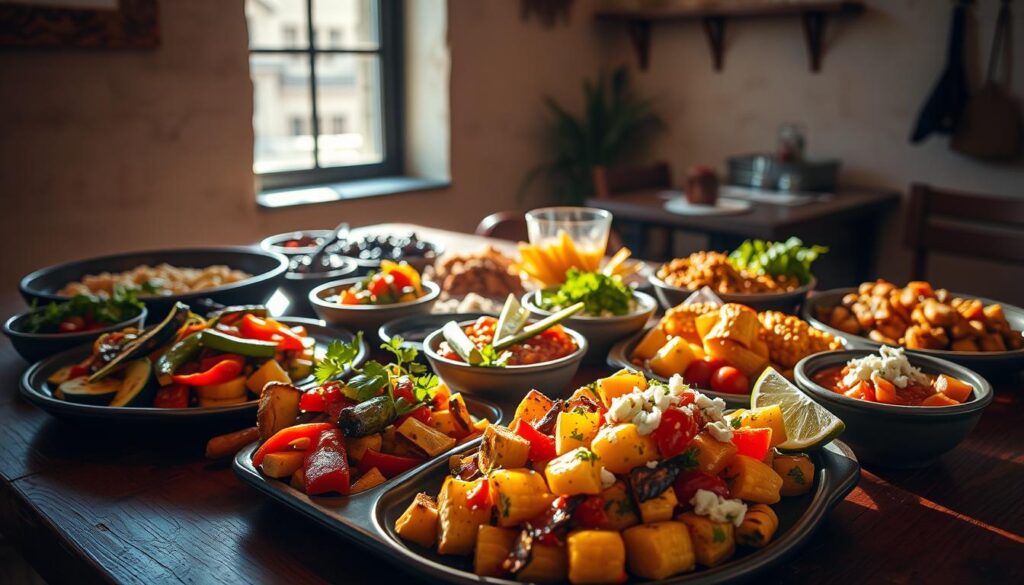Delicious Mexican Vegetable Side Dishes
Spice up your meals with our collection of mexican vegetable side dishes. Easy-to-follow recipes for authentic Mexican flavors.
Picture this: you’re hosting a lively dinner party, and the main course is a sizzling plate of tacos or enchiladas. But what truly steals the show? The vibrant, flavor-packed accompaniments that bring every bite to life. That’s where zucchini steps into the spotlight.
More people are seeking healthier alternatives to classic staples like rice and beans. Zucchini, with its mild taste and versatility, makes the perfect base. Whether grilled, roasted, or sautéed, it soaks up bold spices like smoky paprika and cumin while staying low-carb and paleo-friendly.
Best of all, these dishes adapt effortlessly. Swap in dairy-free cheese or keep it vegan—each variation stays true to authentic flavors. Lime, fresh herbs, and a sprinkle of queso fresco complete the experience.
Key Takeaways
- Zucchini is a star ingredient for light, nutritious options.
- Recipes feature bold spices like cumin and smoky paprika.
- Each serving contains just 16g of carbs, ideal for low-carb diets.
- Easy to customize for vegan or dairy-free preferences.
- Bright finishes like lime elevate the flavors.
Introduction to Mexican Vegetable Side Dishes
Long before modern diets, Mexican kitchens celebrated fresh produce. Staples like zucchini, corn, and peppers were woven into meals, balancing bold spices with natural sweetness. This tradition thrives today, offering a healthier twist on classic mexican food.
Modern adaptations cater to diverse needs. Paleo and Whole30 fans swap grains for roasted veggies, while vegan versions skip dairy without losing authentic flavor. Compared to Americanized plates heavy on cheese and rice, these options pack 2g more fiber per serving.
Ready to explore? Try roasting for smoky depth or sautéing for quick, bright sides. Either method lets spices like cumin and chili powder shine.
Key Ingredients for Authentic Flavor
The secret to vibrant flavors lies in quality ingredients. Whether you’re roasting or sautéing, fresh produce and bold spices make all the difference. Here’s what to reach for:
Fresh Vegetables: Zucchini, Bell Peppers, and Corn
Opt for 3–4 medium zucchini—they roast evenly and hold their shape. Pair them with sweet bell peppers or charred corn for texture. Fresh corn kernels caramelize beautifully, but frozen works in a pinch.
Essential Spices: Cumin, Chili Powder, and Garlic
A base of ½ tsp cumin and ½ tsp garlic powder adds depth. Chili powder brings heat, but adjust to taste. Always toast spices briefly to unlock their aroma.
Cheese Options: Queso Fresco vs. Cotija
Queso fresco crumbles softly, while cotija offers a salty punch. Cotija lasts over a month refrigerated—perfect for stocking up. Both add a creamy finish without overpowering other flavors.
How to Prepare Your Vegetables
Mastering prep work transforms good dishes into great ones. Uniform cuts and balanced seasoning ensure even cooking and bold flavors. Follow these steps to elevate your results.
Chopping Techniques for Even Cooking
Consistency is key. Cut zucchini into 3/4–1″ pieces for even roasting. Smaller julienne strips work well for quick sautéing.
| Cut Type | Best For | Size |
|---|---|---|
| Medium Dice | Roasting, grilling | 3/4–1″ cubes |
| Julienne | Sautéing, stir-fries | 2″ long, 1/4″ thick |
Use separate cutting boards for peppers and cheese to avoid cross-contamination. A sharp knife saves time and ensures clean edges.
Mixing Spices for Maximum Flavor
Combine all ingredients in a bowl first. Layer ½ tsp smoked paprika with a pinch of cayenne for depth. Toast spices briefly to unlock their aroma.
Toss with 2 tablespoons olive oil and season with salt. Let the mixture rest for 10 minutes before cooking. This allows flavors to meld.
Cooking Methods for Perfect Texture
Transform simple ingredients into restaurant-quality meals with the right cooking techniques. The method you choose—whether roasting or sautéing—shapes flavor, texture, and even nutritional value.
Roasting for a Smoky Flavor
Roasting at 425°F caramelizes natural sugars, creating a smoky depth. Use a rimmed baking sheet for even browning or a cast iron skillet for extra crispness. Cook for 25 minutes, flipping halfway.
Watch for browning edges and fork-tender centers. Batch-cook on parchment-lined trays for meal prep—double the recipe without crowding the pan.
Sautéing for Quick and Easy Dishes
Sautéing on medium heat preserves brightness. Avocado oil handles high heat better than olive oil. Stir frequently for even cooking—about 5–7 minutes.
Test doneness with a fork. For larger batches, work in portions to avoid steaming. Finish with a squeeze of lime for freshness.
Variations to Try
Looking to switch up your usual routine? These creative twists bring new life to classic flavors. Whether you crave extra protein, bold heat, or plant-based alternatives, these adaptations keep meals exciting.
Adding Black Beans or Corn
For a hearty boost, mix in 1 can of black beans (15g protein) or roasted corn. Frozen corn works well—just char it in a skillet for smoky sweetness. This combo adds texture and balances spicy notes.
Spicing It Up with Jalapeños
Control the heat by removing jalapeño seeds for mild flavor or keeping membranes for extra spice. Pair them with bell pepper strips for color and crunch. A dash of lime tames the fire.
Vegan and Dairy-Free Options
Skip cheese with nutritional yeast or almond-based toppings. Check spice blends for hidden dairy. Mushrooms add umami depth for a vegan-friendly twist. Seasonal swaps like summer squash keep it fresh year-round.
Serving Suggestions for Mexican Vegetable Side Dishes

A well-balanced meal starts with thoughtful pairings. These vibrant additions complement mains like tacos or enchiladas while adding nutrition and color to your plate. Here’s how to serve them for maximum impact.
Pairing with Tacos and Enchiladas
For tacos, aim for a 1:1 ratio of veggies to protein. Roasted zucchini or peppers add texture without overwhelming flavors. Layer enchiladas with sautéed veggies first—this prevents sogginess.
Pair with black beans and rice for a hearty twist. The beans add protein, while rice balances spicy notes. Serve warm in a chafing dish to maintain temperature during gatherings.
Using as a Filling for Quesadillas
Transform leftovers into a crispy dish. Mix roasted veggies with cheese—queso fresco binds well—and cook on medium heat. Use avocado oil for a higher smoke point and less fat absorption.
For breakfast, try a hash: Sauté veggies with eggs and a dash of chili powder. It’s a quick, flavorful way to repurpose extras.
Nutritional Benefits of Mexican Vegetable Sides
Eating well doesn’t mean sacrificing flavor—these dishes prove it. Packed with just 164 calories per serving and 6g of protein, they’re as nourishing as they are delicious. Whether you’re watching carbs or boosting nutrient intake, these recipes deliver.
Low-Carb and Paleo-Friendly Options
With only 6g net carbs per serving, these dishes fit low-carb and paleo diets. Skip cheese for strict paleo compliance, or use dairy-free alternatives. Lime juice replaces salt, cutting sodium while adding zest.
Rich in Vitamins and Fiber
One serving provides 26mg of *vitamin C* (35% DV) and 3g of fiber. Keep zucchini skins on for extra fiber. Here’s the full macronutrient breakdown:
- 14g fat (healthy oils like avocado)
- 6g carbs (mostly from veggies)
- 6g protein (add black beans for more)
Conclusion
With these easy techniques, you can turn simple ingredients into standout meals. Remember: roasting at 425°F unlocks smoky depth, while fresh cheese like queso fresco adds creamy contrast.
Don’t hesitate to experiment with spice blends. A dash of cumin or smoked paprika can transform your recipe. Share your creations online—tag us for a chance to be featured!
Craving more? Stay tuned for our guide to hearty Mexican soups and stews. Each serving here stays light, ranging from 88–164 calories—perfect for balanced eating.
Now, grab those veggies and start cooking. Your next flavorful meal is just a skillet away.







